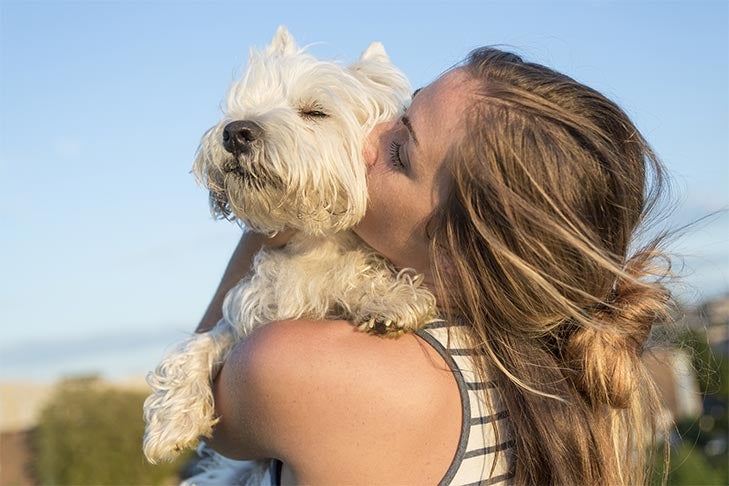Humans don’t question their ability to love their dogs. We feed and exercise them, set our schedules based on their needs, get up with them in the middle of the night, buy them silly toys, and tell them our deepest secrets.
For years, however, scientists and animal behaviorists have researched whether our dogs have the ability to return our love. Are we being anthropomorphic when we interpret our dogs’ behavior in human terms of love?
Summaries of some of these research findings are included below. They may or may not tell you whether dogs are capable of feeling this strong emotion, but the answer for every dog owner lies in your own personal definition of love. Is love defined as a strong bond, a show of affection, the desire to be with you always?
When my Lagotto Romagnolo rests her head on my stomach as I do my morning exercises; when she greets me with her silly smile whether I return from the mailbox or a trip; when she stayed quietly by my side while I recovered from chemo treatments – what I feel is her love.
It’s In Their Genes
In one study, scientists compared how wolf pups and dog pups responded to humans. They took young wolf pups away from their mothers and litters and raised them in human homes. The dog pups had very little human contact while they stayed with their mother and littermates. When they observed all the pups’ responses to people, the dog puppies were much more likely to be attracted and make eye contact. The researchers concluded that “dog puppies are more attracted to humans, read human gestures more skillfully, and make more eye contact with humans than wolf puppies do.”
Another study focused on the tendency of our dogs to stare right into our eyes, communicating love and devotion. Wolves will not look humans in the eye. Researchers found that during domestication, dogs developed a facial muscle that enables them to raise the inner eyebrow intensely. The theory is that this muscle developed from dogs’ motivation to establish eye contact with humans – something they do especially when they need help solving a problem or need to know when communication from humans is directed at them.

Positive Brainwaves
Since dogs are highly dependent on their remarkable sense of smell to evaluate the world around them, animal cognition scientists decided to measure the canine brain’s response to the smell of familiar and unfamiliar people and dogs. They taught their subjects to lie still in magnetic resonance imaging (MRI) machines, so they could observe the dogs’ reactions to five different scents. When these dogs smelled the odor of their owners, as compared to other odors, the caudate nucleus (known as the reward center of the brain) showed activation. “This provides important clues about the importance of humans in dogs’ lives,” the researchers concluded.
Another study of canine and human brain responses focused on sounds made by humans and dogs. The scientists observed that human and dog brains react similarly to emotion-laden sounds. For example, happy sounds light up the same area of the brain – the auditory cortex – in both. These similar reactions seem to indicate a strong ability to communicate types of emotions across species.
Love Hormone
Oxytocin, known as the love hormone, is present when humans and animals interact. Scientists studied the role of oxytocin in a dog’s brain as an influence on social interactions with humans and with other dogs. They found evidence that oxytocin enhances social motivation in dogs to approach and interact with their dog partners (picture “Lady and the Tramp“) and their human partners.
Researchers in Sweden also studied oxytocin levels in dogs and their owners. They observed that dogs and their owners responded in similar ways to their interactions (such as petting) regarding oxytocin levels. Calm, anti-stress behaviors in the human caused a similar response in the dog. They concluded that “the owners and the dogs could mutually sense the other’s emotional state based on an increased ability to read the other’s behavioral cues . . . oxytocin can facilitate and stimulate friendly social interactions, induce anti-stress effects, and increase trust.”

Use the Word
Clive Wynne, a psychologist and founder of the Canine Science Collaboratory at Arizona State University, is the author of a book called “Dog Is Love: Why and How Your Dog Loves You.” In an interview in The Washington Post, when asked whether his dog Xephos loves him, he said:
“I know that sometimes Xephos just wants dinner. But I’m pretty convinced that that’s not the whole picture. She really does feel a bond, a connection toward me that’s as real as any other connection that any other individual in my life might feel toward me.
“I’m not saying human and dog love are identical. I’m just saying there’s enough similarity between how dogs form strong emotional bonds and how people form strong emotional bonds that it’s fair enough to use the love word.”
Does my dog offer real love? Does yours? The answer lies in the happiness your dog brings you. Author Carolyn Knapp summed up my answer to the question in her book “Pack of Two”: “Before you get a dog, you can’t quite imagine what living with one might be like; afterward, you can’t imagine living any other way.”

